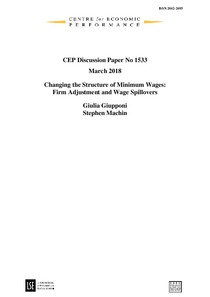Changing the structure of minimum wages: firm adjustment and wage spillovers
"This paper analyses the economic impact of a significant change to the structure of a minimum wage setting policy. The context is the United Kingdom where government mandated an unexpected change in the structure of minimum wages and their setting in 2016 by introducing a new minimum wage – th...
| Main Authors: | , |
|---|---|
| Institution: | ETUI-European Trade Union Institute |
| Format: | TEXT |
| Language: | English |
| Published: |
London
2018
LSE |
| Subjects: | |
| Online Access: | https://www.labourline.org/KENTIKA-19398984124911161669-Changing-the-structure-of-mini.htm |
| Summary: | "This paper analyses the economic impact of a significant change to the structure of a minimum wage setting policy. The context is the United Kingdom where government mandated an unexpected change in the structure of minimum wages and their setting in 2016 by introducing a new minimum wage – the National Living Wage (NLW) – for workers aged 25 and over. The new NLW rate was significantly higher than the minimum wage for those under age 25. The analysis studies the consequences of this change in a sector containing many low wage workers, the care homes industry. The new minimum wage structure and associated higher minimum wage for those aged 25 and above significantly affected wages, but at the same time with little evidence of adverse employment effects, nor firm closure. Rather the margin of adjustment used to offset the sizable wage cost shock was a significant deterioration of the quality of care services. There is also strong evidence of wage spillovers as younger workers wages rose in tandem with the higher adult minimum wage, but with no impact on their employment. Based on further empirical tests, employer preference for fairness seems to offer the most plausible explanation for these results." |
|---|---|
| Physical Description: | 71 p. Digital |

